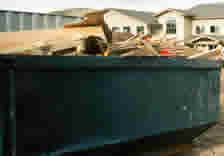|
BUILDING -
RELATED C & D WASTE CHARACTERISTICS |
Local, state and federal governments classify construction and
demolition (C&D) waste as "solid waste" that includes materials
generated from construction and demolition activities for the transportation,
building, and land clearing industries, as well as disaster debris. Building-related
C&D waste includes building materials (asphalt shingles, insulation, concrete,
wood, gypsum drywall, PVC, metals, etc.), packaging materials (cardboard, styrofoam,
straps, pallets, etc.), tree stumps, and rubble resulting from construction,
remodeling, repair, and demolition of homes, commercial buildings and other
structures and pavements. "Hazardous waste" or potentially harmful
materials may also be contained in building-related debris, although they are
not generally included in the official definitions of C&D waste. These materials
including lead, asbestos, mercury, liquid paints and stains, pressure treated
lumber, etc. must be removed and disposed according to practices and regulations
beyond those for C&D waste.
A study conducted by the United States Environmental Protection
Agency (EPA) indicates that building-related C&D waste totaled approximately
136 million tons in 1996. Of this amount, approximately 57% was non-residential
and 43% was residential. New construction generated an estimated 11 million
tons (8%), renovation 60 million tons (44%) and demolition another 65 million
tons (48%).
Building-related C&D waste contributes significantly to the
total waste stream flowing into the nation's landfills with estimates ranging
from 10 - 30 percent of total waste. Construction waste disposal is regulated
on the state and local level. Therefore, the guidelines for disposing of construction
wastes vary from state to state. Construction wastes used to be burned in fires
or buried on-site. However, these practices have been widely abandoned and in
most states, made illegal.

Building site -- C&D waste bin
|
As of 1996, EPA reported that most construction waste generated in the
U.S. is thrown into dumpsters and hauled to either a permitted construction
and demolition (C&D) waste landfill or a municipal solid waste
facility. There were an estimated 1800 C&D landfills operating in
the United States in 1995. The EPA estimates 20 - 30 percent was being
recovered for reuse or recycling in 1996. Approximately 3,500 operating
facilities processed this C&D for recovery.
|
The composition of building-related construction and demolition
debris varies due to the nature of construction activity. Demolition sites generate
more concrete, asphalt and metals while construction generates more corrugated
containers, wood and gypsum wallboard. Demolition and remodeling activities
are more prone to generate asbestos and lead-contaminated materials.
Results of waste generated at 15 residential construction projects
compiled by the EPA demonstrates a large variation in waste generation amongst
single-family home construction. Waste generated from these homes ranged from
2.41 to 11.30 pounds per square foot, with an average generation of 6.14 pounds
per square foot. Home size does not appear to have been the determining factor
for waste production, other factors including contractor, materials chosen or
special circumstances may have more to do with waste generation than size of
home.
A study conducted by the National Association of Home Builders
Research Center, estimated that 8,000 lbs. of waste is thrown into the landfill
during construction of a typical 2,000 square foot home. The makeup of this
waste is estimated in the table below.
|
Material
|
Weight (in pounds)
|
Volume (in cubic yards)*
|
|
Solid Sawn Wood
|
1,600
|
6
|
|
Engineered Wood
|
1,400
|
5
|
|
Drywall
|
2,000
|
6
|
|
Cardboard (OCC)
|
600
|
20
|
|
Metals
|
150
|
1
|
|
Vinyl (PVC)**
|
150
|
1
|
|
Masonry***
|
1,000
|
1
|
|
Hazardous Materials
|
50
|
-
|
|
Other
|
1,050
|
11
|
|
Total
|
8000
|
50
|
|
*Volumes are highly variable due to compressibility and captured
air space in waste materials.
**Assuming three sides of exterior clad in vinyl siding.
***Assuming a brick veneer on home's front facade.
Source: NAHBRC, Residential Construction Waste:
From Disposal to Management
|
|
Although construction wastes vary from one site to another, other studies
reflect similar trends in characteristics of waste materials with wood,
drywall and cardboard contributing the largest percentages of material.
Materials in the "other" category may include glass, ceramic,
aggregate, rubble, paper and paperboard, plastic, electrical wire, carpet,
rubber, insulation, and miscellaneous items and scraps.
Many of these materials can be reused/salvaged or recycled,
especially the wood, cardboard, and drywall. Over 70% reduction in waste
would be achieved if these three materials were reused or recycled, thus
saving resources, money and landfill space. Reduction of waste through
prevention methods may also reduce the financial and environmental impacts
of construction waste.
Many states have programs, run by government or private
organizations, that work to enhance Construction and Demolition recycling.
Some programs recognize the economic benefits of developing this inherently
local industry while others wish to capture the lost resources and reduce
impact to landfills. Material
exchanges are one product of these programs. "Green Building"
programs provide contractors with support to reduce waste through product
choices and techniques as well as recycling waste materials that are generated.
|
References:
U.S. Environmental Protection Agency (EPA), Characterization of Building-
Related Construction and Demolition Debris In The United States, 1998 http://www.epa.gov/epaoswer/hazwaste/sqg/c&d-rpt.pdf
NAHB Research Center, Residential Construction Waste:
From Disposal to Management
http://www.nahbrc.org/tertiaryR.asp?TrackID=&DocumentID=2301&CategoryID=819
 |
(Fact Sheet 1 of 10)
|
|
